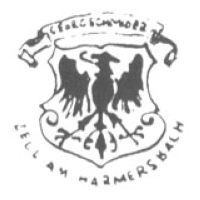
Image 010112-02-01
The first mark used by Schmider, registered at the RWZR as №·25·970 on August 14th 1897.
The period before the founding of the second factory in the town of Zell am Harmersbach had seen a lot of changes as can be seen when viewing the history of the first factory that opened there and which by now had become the Zeller Steingut- und Porzellanfabrik C. Schaaff. Expanding industry in the area lead to the founding of a second factory for stoneware products in 1859, directly at the town gate in the Biberach direction of town and as the older factory was located on higher ground, the new factory quickly became known as Untere Fabrik ("lower factory"). One of the partners of the new company was a former employee of Haager, Hoerth & Co., Georg Schmider, who eventually took over all shares in 1897.
Shortly after Schmider took over the works the well-known artist Elisabeth Schmidt-Pecht designed the Favorite series for Schmider and continued to sporadically work for him until 1914. Even if Favorite was very successful indeed it could not beat a design which evidently changed the whole industry in and around Zell am Harmersbach: the Hahn und Henne ("rooster and hen") decoration was created in 1898 by chief decorator Karl Schöner to commemorate the birth of his daughter and it became the most famous decoration style from the area - in fact, it is still the most used decoration style even today. Success was overwhelming and Schmider had to drastically increase his production capacity to cover demand, so he took over the company of Schaible & Co. (founded 1859), directly followed by Haager, Hoerth & Co. (founded 1873) in close succession during 1898 and renamed his company into the Vereinigte Zeller Fabriken.
In 1899 both the Upper and Lower works were slightly damaged by a massive fire that broke out in the middle of the town, only to be followed by another blaze in 1904. But Schmider was not put off easily as his products were a constant success and in 1907 he was finally able to take over the 'Upper Factory' from the Carl Schaaff company. Over the years the items from the Zell works were exported to Africa, Austria, Belgium, Canada, Denmark, Holland, France, India, Italy, Norway, Romania, Sweden, Switzerland and the United States. But not only self-marked items were sold; apparently quite a few goods were also sold as unbranded or customer-branded ware. One example would be from the period between 1907 and 1928 when the company sold at least one series of decorated but unmarked plates to the US importer Leon D. Bloch & Co. from New York who also ordered items from a few other German companies like the Porzellanfabrik Moschendorf AG. An example for the Vereinigte Zeller Fabriken mark can be found in the marks section below.
The Favorite and Hahn und Henne series where just a start and backed by full order books the factory reached its peak number of 500 employees in 1925. During this extremely successful period Schmider had a helping hand in his son-in-law Heinrich Haiss. Young Mr. Haiss was everything Schmieder (who only had a daughter) could dream of. He was an intelligent businessman with the right feeling for the market and what impressed Schmider most was that instead of constantly explaining something again and again, Haiss would rather take off his jacket and show the people what he meant or how something should be done which of course earned him a lot of respect with the factory workers.
It did not take long and Schmider made Haiss director of the factory and left everything in his hands. Staying in the background for his last years, Schmider died in 1934. Haiss who later introduced his son Günter Haiss to the trade successfully managed the following years and even the war years were extremely successfull, especially when taking in mind that production had to be stopped during 1942 because no raw materials could be aquired. 1942 also was the year in which it was decided to discontinue porcelain production generally and after restarting production in 1946, the factory only produced cheap single-colored pieces. Finally in 1963 the former Upper Factory was closed down and production completely taken over by the modernized Lower Factory.
Before filing for insolvency procedures in 1987 the business had been in the hands of Schmider and Haiss descendants. The business nearly shut down for good, but in 1990 the business was taken over by the real estate company Herbert Hillebrand Baubetreuungs- und Grundbesitz KG Interestingly enough, the Hillebrand company also owned the facilities of Weimar Porzellan GmbH. in Blankenhain and the Wallendorfer Porzellanmanufaktur GmbH. in Wallendorf. But the so-called Hillebrand Group went bankrupt and was broken up in 1994. The factory went through some hard times until the remaining Hillebrand KG was able to re-structure the company.
Since 1997 the business was known as Zeller Keramik Geschwister Hillebrand GmbH and planned to open the Haiss manor as porcelain museum, offering enough room for other art-related or historic displays.
During the process in which the Geschwister Hillebrand group was restructured and repositioned, two businesses were renamed and offered for sale. One of those two was Zeller Keramik, which from January 1st 2006 tried to stand on its own feet again. A promised investment from the Hillebrand group never came, and so the factory soon ran into financial difficulties, forcing the management to apply for insolvency procedures in December 2007.
The following years saw the company reposition itself completely, successfully concentrating more on the artistic aspect of ceramics, seeing that the market for standard household goods was slowly flooded by cheap Asian imports and would therefore not offer any chances for expansion in the near future. All time design classics like "Hahn und Henne" were of course kept, other designs either dropped or relaunched; art related events even managed to attract younger customers again. In 2018 Zeller Keramik was once again a strong business and decided to purchase the renown Karlsruher Majolika (which had been threatened by closure) in an effort to expand the art-related product portfolio even further. Success was short lived, though. Due to rising energy costs the business had to apply for insolvency proceedings in September 2023 and was forced to close a short time later.
The often included flanking initials "S.P." stand for the designer, Elisabeth Schmidt-Pecht.

Image 010112-02-01
The first mark used by Schmider, registered at the RWZR as №·25·970 on August 14th 1897.
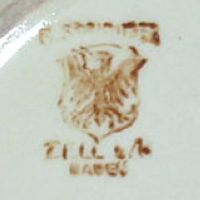
Image 010112-02-02
Also introduced 1897 but apparently used up until 1925, "G. Schmider" above an eagle on a shield above "Zell a/H" above "Baden".
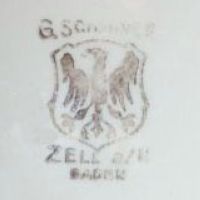
Image 010112-02-03
Another example of the same mark, "G. Schmider" above an eagle on a shield above "Zell a/H" above "Baden".
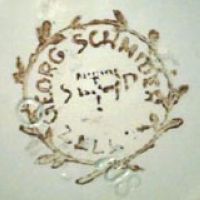
Image 010112-03-01
Used between 1898 and 1928, registered at the RWZR as №·32·440 on August 23rd 1898.
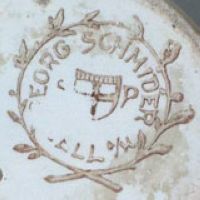
Image 010112-03-02
Used between 1898 and 1928, another example.
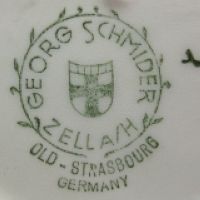
Image 010112-03-03
Undated example, this time without flanking "SP". Found on an item from the "Old Strassbourg" series.
(Picture: Ron Mccutchan).
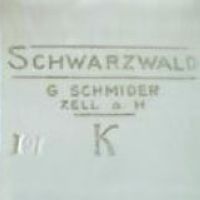
Image 010112-03-04
Used around 1900, decoration name "Schwarzwald" above "G. Schmider" above "Zell a/H".
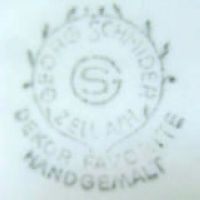
Image 010112-03-05
Used between 1907 and 1928, here a slightly different version showing "Dekor Favorite".
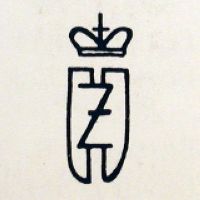
Image 010112-03-06
Used between 1907 and 1928.
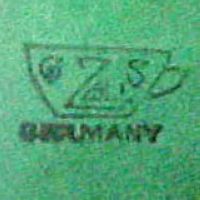
Image 010112-03-07
Used between 1907 and 1928, stamped version with the addition "Germany". Registered at the RWZR as №·104·648 on January 29th 1908.
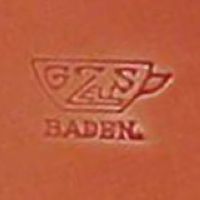
Image 010112-03-08
Used between 1907 and 1928, here an example of the impressed version with the addition "Baden".
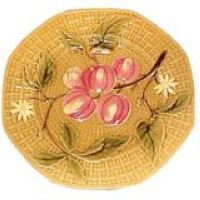
Image 010112-03-09
As mentioned above, here is an example of a Zell piece (one from a set of six different plates)...
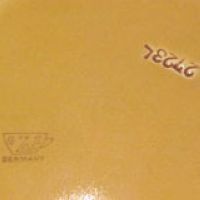
Image 010112-03-10
... with the Zell cup mark and the impressed number "2723L".
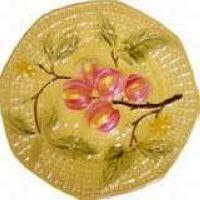
Image 010112-03-11
Sorry that color and contrast are off a bit, but it is the same item as shown in the first example ...
(Picture: Jean Rogan)
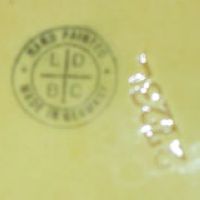
Image 010112-03-12
... only this time with the New York importer Leon D. Bloch & Co. mark next to the impressed number '2723L'.
(Picture: Jean Rogan)
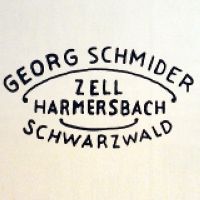
Image 010112-03-13
Used around 1924 on porcelain only, here with "Schwarzwald" series name addition.
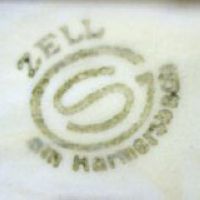
Image 010112-03-15
Used from 1933 onwards, "Zell" above initials "G" and "S" above "am Harmersbach".
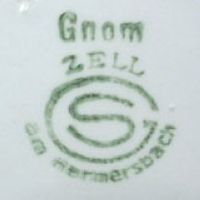
Image 010112-03-16
Used from 1933 onwards, standard mark together with the decoration name "Gnom" ("Gnome").
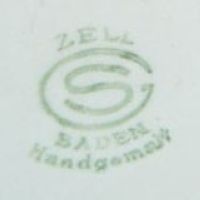
Image 010112-03-17
Used from 1933 onwards, variation with the addition "Baden" over "handgemalt".
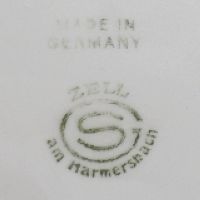
Image 010112-03-18
Used from around 1960, here with "Made in Germany" addition.
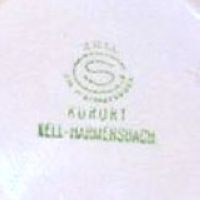
Image 010112-03-19
Used from around 1970, here with the addition "Kurort Zell-Harmersbach" ("Kurort" means health resort or spa).
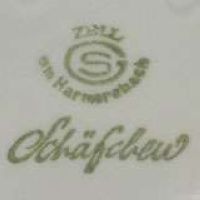
Image 010112-03-20
Used from around 1970, here with the series name "Schäfchen"
(Picture: Lisa Brooks)
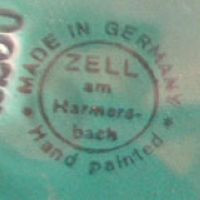
Image 010112-03-21
No date known, "Zell am Harmersbach" surrounded by "Made in Germany" and "Hand painted".
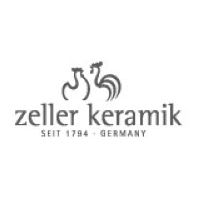
Image 010112-05-01
Mark and company logo from 1997 onwards.
© 2004-2025 C.S.Marshall, all rights reserved